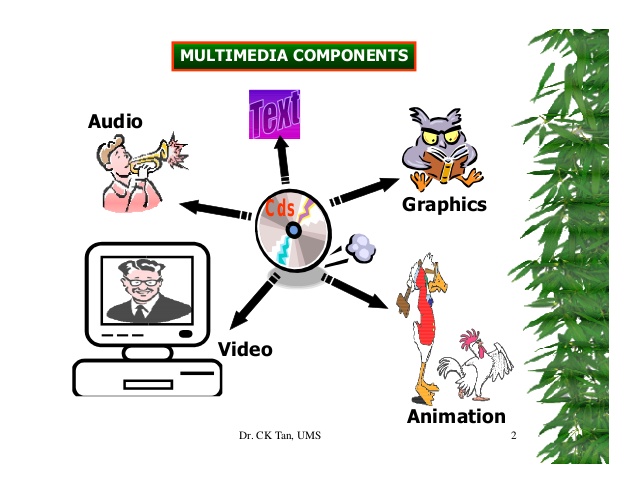The Use of Multimedia in English Teaching ZHANG Zhen
What is multimedia?
Multimedia is the field concerned with the computer-controlled integration of text, graphics, drawings, still and moving images (Video), animation, audio, and any other media where every type of information can be represented, stored, transmitted and processed digitally.
The Definition of multimedia
The use of computers to present text, graphics, video, animation, and sound in an integrated way.
The use of multimedia in English teaching
Components of Multimedia
Text ➤ It is fundamental element in all multimedia applications.Graphics ➤ It refers to images and pictures, such as chart, diagram, and photograph, which contain no movement.
Animation ➤ It is The rapid display of a sequence of images of 2-D or 3-D artwork or model positions in order to create an illusion of movement.
Sound ➤ It is speech, music, or any other sound that is stored and produced by computers. It has more advantages than tape recorder.
Video ➤ It is the visible part of a television transmission and broadcasts visual images of stationary or moving objects.
The Setting of Multimedia Classroom
(1) MPC—multimedia personal computer;(2) VCD/DVD player—video compound disk/digital video disk;
(3) Amplifier and Hi-Fi acoustic system;
(4) Overhead/slide projector;
(5) Screen/curtain;
(6) Projecting apparatus;
(7) The Internet access;
(8) Cassette tape recorder;
(9) Camera recorder.
The Necessity of Multimedia in English Teaching
The Necessity of Development of Modern Educational TechnologyModern educational technology, which is characterized by more information and stronger intuitive, is a combination of modern education and modern technology.
The Needs of Quality Education
The answer is that multimedia is one of the ways to promote the development of quality education. Multimedia English language teaching can enable students to be involved in a variety of sensory organ in the learning process and stimulate the students in the corresponding cortical function area.
The Needs of Students’ Cognitive Mental
Cognitive psychology studies have shown that 94% of the information learned through the visual and auditory access, of which 88% is obtained through the vision, 12% through hearing.
The Multimedia Teaching
Advantages
Arousing the students’ interest.
Famous scientist Albert Einstein had a famous saying: “Interest is the best teacher”. So the interest has always been seen as the best helper to learn the knowledge.
Improving students’ self-learning ability.
The most important thing is teaching students how to learn and making students change
from “want me to study” to “I want to learn” in thinking, from passive learning to active learning.
Improving students’ innovative ability.
Meanwhile, multi-media teaching can also develop student’s
ability to innovate. Things need to innovate, Einstein said: “Imagination is more important than knowledge, and
is a source of knowledge”.
Cultivating students’ communication skills.
Through multi-media teaching, we can create real-life scenes in the classroom. It is not only to shorten
the distance between teaching and practice and give students the opportunity to use English to communicate.
Increasing classroom capacity.
The use of multimedia technologies can
make students notice a clear knowledge and a new expansion by huge information capacity which shows by all
kinds of media.
Problems
Confusion ⟹ Some English classes are totally dependent on multi-media, ignoring the role of teachers. What is worse, some teachers have directly brought a CD-ROM
courseware for their lessons, or copy other people’s courseware overall.
Performance on behalf of the lead ⟹ the
teachers use the multi-media presentation to replace the guidance of teachers completely.
Lack of special skill ⟹ There are many multimedia teachers who just have half-baked knowledge. The preparation and workload of teachers
increase virtually. And multimedia teaching requires teachers with multimedia computer operation experience.
Owing to traditional educational system, many teachers are not good at computers.
Over-use of multimedia ⟹ The teachers turn the multimedia
classroom into a show stage and what they act in class is nothing but a new generation of button-pusher. Because of the
teacher’s lack of enthusiasm and creation and his or her dependence on the multimedia technology, the teachers
act as sole information-giver to the students.
Lack of interaction between teachers and students ⟹ The tie between the teachers and students becomes loose and it seems to them that teacher is only
caring about the machine and they are also focusing on the screen.
Strategies for Using Multimedia
Combining Modern Teaching Methods With Traditional Teaching Methods
Teachers should combine their strong points with modern teaching methods, which not only
raise classroom teaching quality and efficiency, but also improve teaching and learning environment between
teachers and students.
Viewing Multimedia as the Assistance to Teaching
Multimedia enables students to manipulate and create material to learn by
doing. But when we use computers in the teaching, we should understand they can only assist but cannot take
place of all the other teaching methods. Therefore, multimedia can only be used as a supplement to
classroom English teaching.
Building the Ideal Relationship Between Teachers and Students
Teachers should
play a leading role in the teaching. In the past, students were thought of to be passive knowledge receiver.
Strengthening Teacher Training
It
is a challenge for teachers using multimedia because of heavy preparation work and increasing workload. They should know well about modern
educational theories and techniques.
The Principles of Multimedia-Assisted Teaching
(1) Scientific principles. Namely, courseware design cannot appear any errors;
(2) Subsidiary principle. We must always adhere to: Although multi-media teaching has many advantages, it
is only a supplementary means, and does not substitute for the role of people;
(3) Interactivity principle. More interactivity between teachers and students, students and multimedia, more
effective results we will have;
(4) Combination principle. Combine the advantages of modern teaching and the traditional teaching
organically
regardless of the difficulties lying ahead, we must admit that multimedia do make a revolutionary impact on language teaching. To be sure, it is a permanent task for a teacher to do more and deeper studies in the application of multimedia. It is no doubt that more practical and effective ways can be worked out to improve English teaching.
















